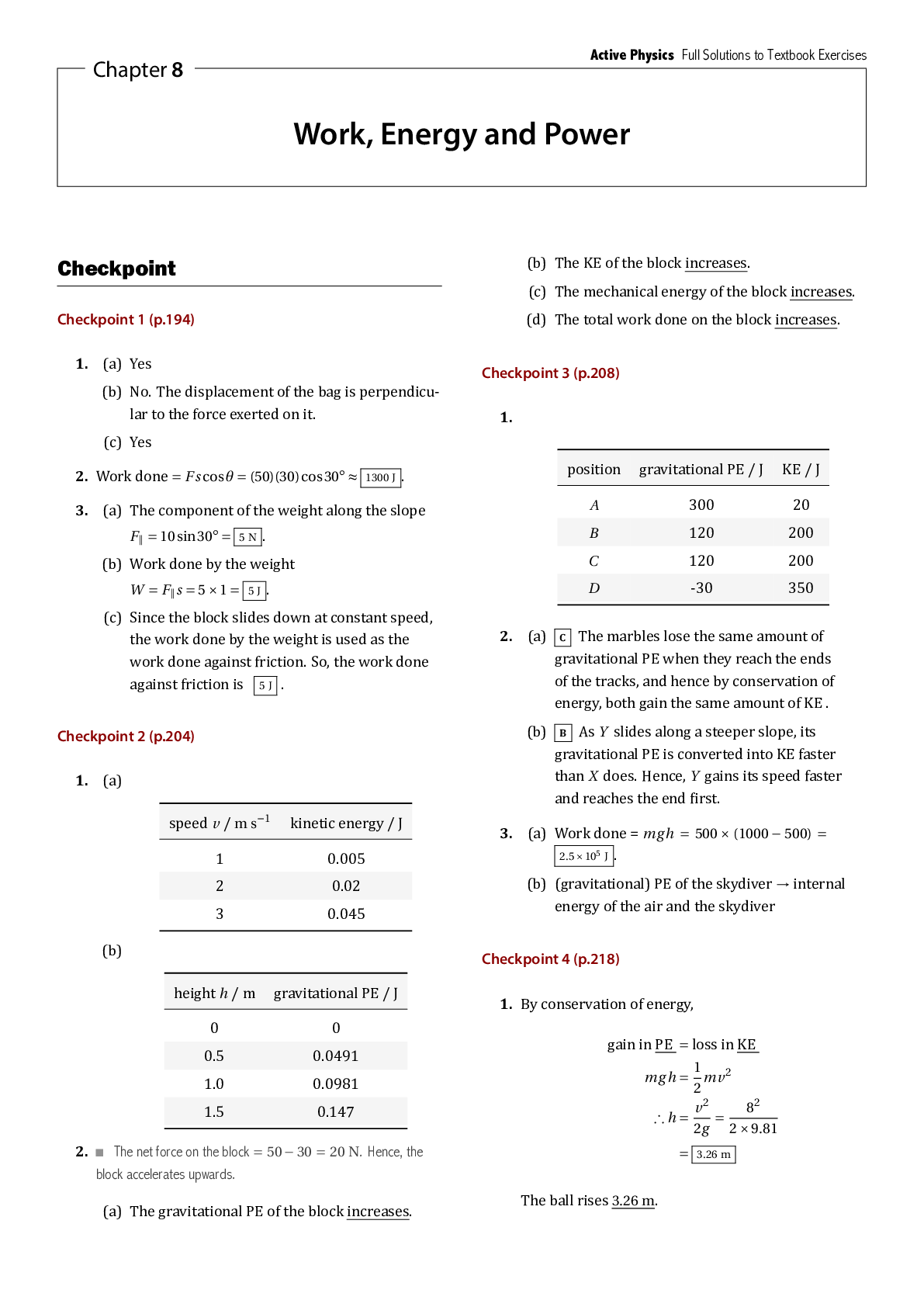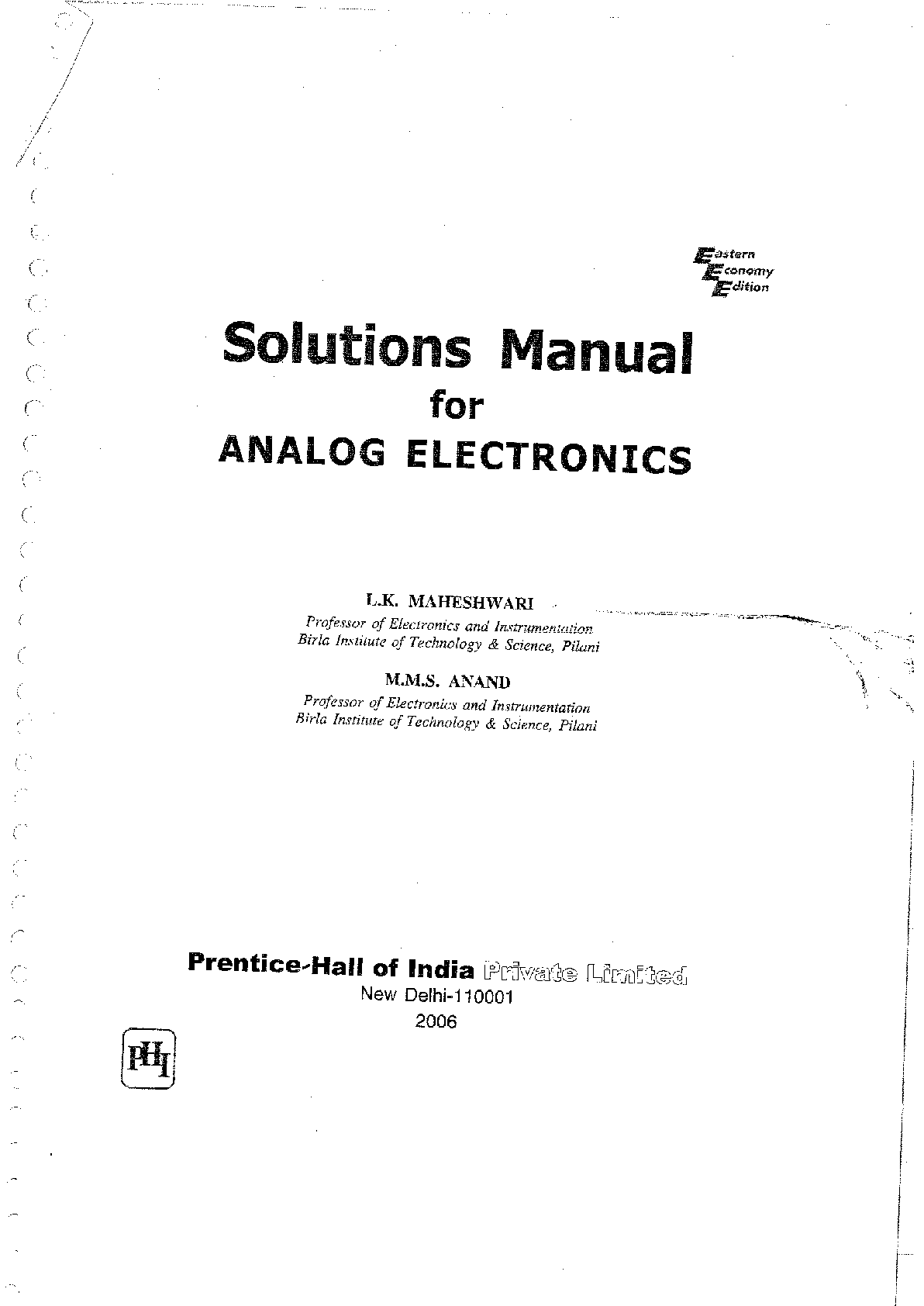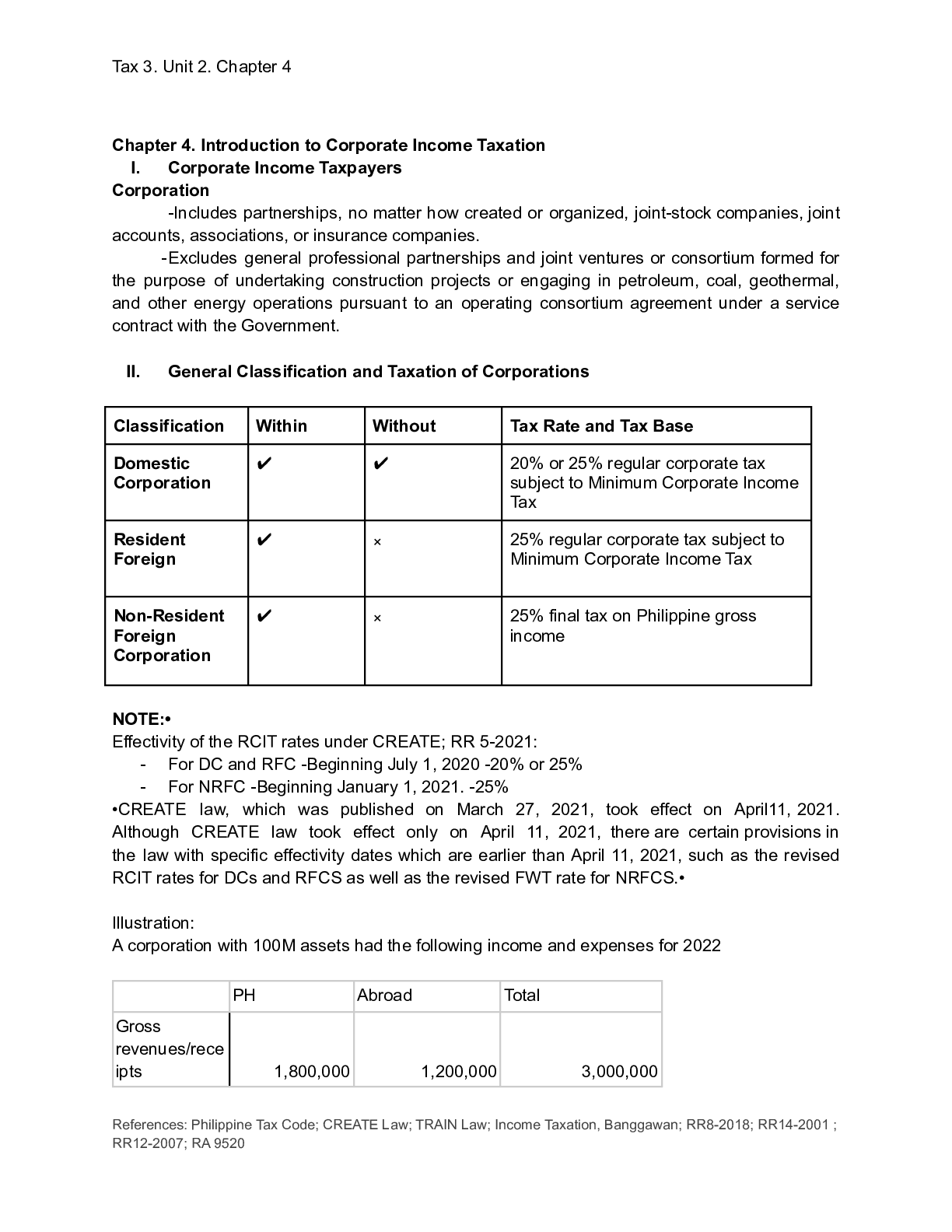Physics > SOLUTIONS MANUAL > Answers/Solutions > Chapter 8 Work, Energy and Power. Active Physics Full Solutions to Textbook Exer (All)
Answers/Solutions > Chapter 8 Work, Energy and Power. Active Physics Full Solutions to Textbook Exercises
Document Content and Description Below
Active Physics Full Solutions to Textbook Exercises Chapter 8 Work, Energy and Power Checkpoint Checkpoint 1 (p.194) 1. (a) Yes (b) No. The displacement of the bag is perpendicular to the force ... exerted on it. (c) Yes 2. Work done ˘ F s cosθ ˘ (50)(30)cos30° … 1300 J . 3. (a) The component of the weight along the slope F∥ ˘ 10sin30° ˘ 5 N . (b) Work done by the weight W ˘ F∥s ˘ 5£1 ˘ 5 J . (c) Since the block slides down at constant speed, the work done by the weight is used as the work done against friction. So, the work done against friction is 5 J . Checkpoint 2 (p.204) 1. (a) dummy speed v / m s¡1 kinetic energy / J 1 0.005 2 0.02 3 0.045 (b) dummy height h / m gravitational PE / J 0 0 0.5 0.0491 1.0 0.0981 1.5 0.147 2. The net force on the block ˘ 50 ¡ 30 ˘ 20 N. Hence, the block accelerates upwards. (a) The gravitational PE of the block increases. (b) The KE of the block increases. (c) The mechanical energy of the block increases. (d) The total work done on the block increases. Checkpoint 3 (p.208) 1. dummy position gravitational PE / J KE / J A 300 20 B 120 200 C 120 200 D -30 350 2. (a) C The marbles lose the same amount of gravitational PE when they reach the ends of the tracks, and hence by conservation of energy, both gain the same amount of KE . (b) B As Y slides along a steeper slope, its gravitational PE is converted into KE faster than X does. Hence, Y gains its speed faster and reaches the end ϐirst. 3. (a) Work done = mgh ˘ 500 £ (1000 ¡ 500) ˘ 2.5£105 J . (b) (gravitational) PE of the skydiver ! internal energy of the air and the skydiver Checkpoint 4 (p.218) 1. By conservation of energy, gain in PE ˘ loss in KE mgh ˘ 1 2 mv2 ) h ˘ v2 2g ˘ 82 2£9.81 ˘ 3.26 m The ball rises 3.26 m.2 | Chapter 8 Work, Energy and Power Exercise Active Physics Full Solutions to Textbook Exercises 2. By conservation of energy, the work done by the resistive force ˘ loss in (gravitational) PE ˘ mgh ˘ 5000£(20¯2) ˘ 1.1£105 J Average resistive force F ˘ W s ˘ 1.1£105 2 ˘ 55000 N Checkpoint 5 (p.224) 1. Work done by the crane W ˘ F∥s ˘ 20000£20 ˘ 4£105 J Power of the crane P ˘ W t ˘ 4£105 50 ˘ 8000 W Alternative Solution: Speed of the load v ˘ s t ˘ 20 50 ˘ 0.4 m s¡1 Power of the crane P ˘ F v ˘ 20000£0.4 ˘ 8000 W 2. B Let a be the acceleration of the car. Power of the car P ˘ F∥s t ˘ mas t ˘ m ( v22 ) t ˘ mv2 2t Exercise Exercise 8.1 (p.194) 1. B W ˘ F s ˘ mas ) [J] ˘ [kg][m s¡2][m] ˘ [kg][m2 s¡2] 2. B If the length of the barrel is longer, the cannonball is acted on by the force for a longer distance (i.e. larger s). By W ˘ F s, a larger s leads to a larger work W to be done on the cannonball, which hence gains a larger KE . 3. B 4. A The normal reaction exerted by the ground is perpendicular to the direction of motion of the crate. 5. The net work done ˘ Fnets ˘ (5¡2)£3 ˘ 9 J . 6. (a) The work done by the pulling force ˘ F∥s ˘ (20cos45°)(50) ˘ 707.1 … 707 J . (b) The work done against friction ˘ f s ˘ (8)(50) ˘ 400 J . (c) The energy gained by the suitcase ˘ 707.1¡400 … 307 J . 7. By W ˘ F s, we have energy gained ˘ area under the F–s graph ˘ 5£2 2 ˘ 5 J So the energy gained by the block is 5 J . 8. (a) Since the dumbbell is lifted at a constant speed, the force exerted by Carol is equal to the weight of the dumbbell. The work done by Carol is W ˘ F s ˘ mg s ˘ (10)(9.81)(0.3) … 29.4 J (b) When the dumbbell falls, the only force acting on the dumbbell is the gravitational force exerted by the Earth. The work done by the Earth is W ˘ F s ˘ mg s ˘ (10)(9.81)(0.8) … 78.5 J 9. (a) The work done against friction is W ˘ f s ˘ (0.3)(2…£0.2£ 14) … 0.0942 J (b) The work done by the gravitational force is W ˘ mg s ˘ (0.1£9.81)(0.2) … 0.196 J Exercise 8.2 (p.204) 1. (a) The gain in PE ˘ mgh ˘ (120)(9.81)(2) … 2350 J . (b) The KE ˘ 1 2mv2 ˘ 1 2(0.43)(82) … 13.8 J . 2. C By KE ˘ 1 2mv2, we have KE / v2. If v is doubled, then the KE is 4 times of the original value. 3. A Since KE ˘ 1 2mv2, the slope of the graph is m2 . If the mass m is doubled, then the slope is doubled. 4. C The change in the height of the marble is the same no matter it slides down rails A or B.Active Physics Full Solutions to Textbook Exercises Chapter 8 Work, Energy and Power Exercise | 3 5. D Note that work has to be done to stretch the spring. The spring does not gain any gravitational PE since it (more precisely, its c.g.) does not have any vertical motion. 6. (a) The KE of the car is KE ˘ 1 2 mv2 ˘ 1 2 (2000)(122) ˘ 1.44£105 J (b) When the car comes to a stop, the KE of the car must have been transformed into the work done against friction. Given that the braking force is 3500 N, we have KE ˘ F s 1.44£105 ˘ 3500s ) s … 41.1 m ˙ 50 m Yes. The car can stop before the ϐlock of sheep. 7. The gravitational PE of John is given by gravitational PE ˘ mgh ˘ (70)(9.81)(6sin38°) … 2540 J 8. (a) If the cannonball is ϐired horizontally, the work done on the cannonball is equal to the gain in its KE , and hence F s ˘ 1 2 mv2 (20000)(1) ˘ 1 2 (15)v2 ) v … 51.6 m s¡1 The speed of the cannonball is 51.6 m s¡1 . (b) Free body diagram of the cannonball when it reaches the end of the barrel: Since the net work done on the cannonball is equal to the gain in its KE , we have (F ¡mg)s ˘ 1 2 mv2 (20000¡15£9.81)(1) ˘ 1 2 (15)v2 ) v … 51.4 m s¡1 The speed of the cannonball is 51.4 m s¡1 . OR: The work done on the cannonball is equal to the sum of its KE and gravitational PE , and so F s ˘ 1 2 mv2 ¯mgh (20000)(1) ˘ 1 2 (15)v2 ¯(15)(9.81)(1) ) v … 51.4 m s¡1 9. The y-intercept of the graph represents the initial gravitational PE of the block. Thus grav. PE ˘ mgh 1000 ˘ (10)(9.81)h ) h ˘ 10.19 … 10.2 m The vertical distance travelled by the block is 10.2 m . Consider the ϐigure below. Therefore, we have sinθ ˘ 10.19 50 ) θ … 11.8° 10. (a) Take the initial gravitational PE of the box as zero. The work done on the box is W ˘ F s ˘ (8)(20) ˘ 160 J (b) The gain in KE is KE ˘ 1 2 mv2 ˘ 1 2 m(22) ˘ 2m The gain in gravitational PE is PE ˘ mgh ˘ m(9.81)(20sin30°) ˘ 98.1m Combining the equations, we have work done ˘ KE gain¯PE gain 160 ˘ 2m ¯98.1m ) m ˘ 160 100.1 … 1.60 kg [Show More]
Last updated: 1 year ago
Preview 1 out of 12 pages
Instant download

Buy this document to get the full access instantly
Instant Download Access after purchase
Add to cartInstant download
Reviews( 0 )
Document information
Connected school, study & course
About the document
Uploaded On
Jan 19, 2023
Number of pages
12
Written in
Additional information
This document has been written for:
Uploaded
Jan 19, 2023
Downloads
0
Views
44






